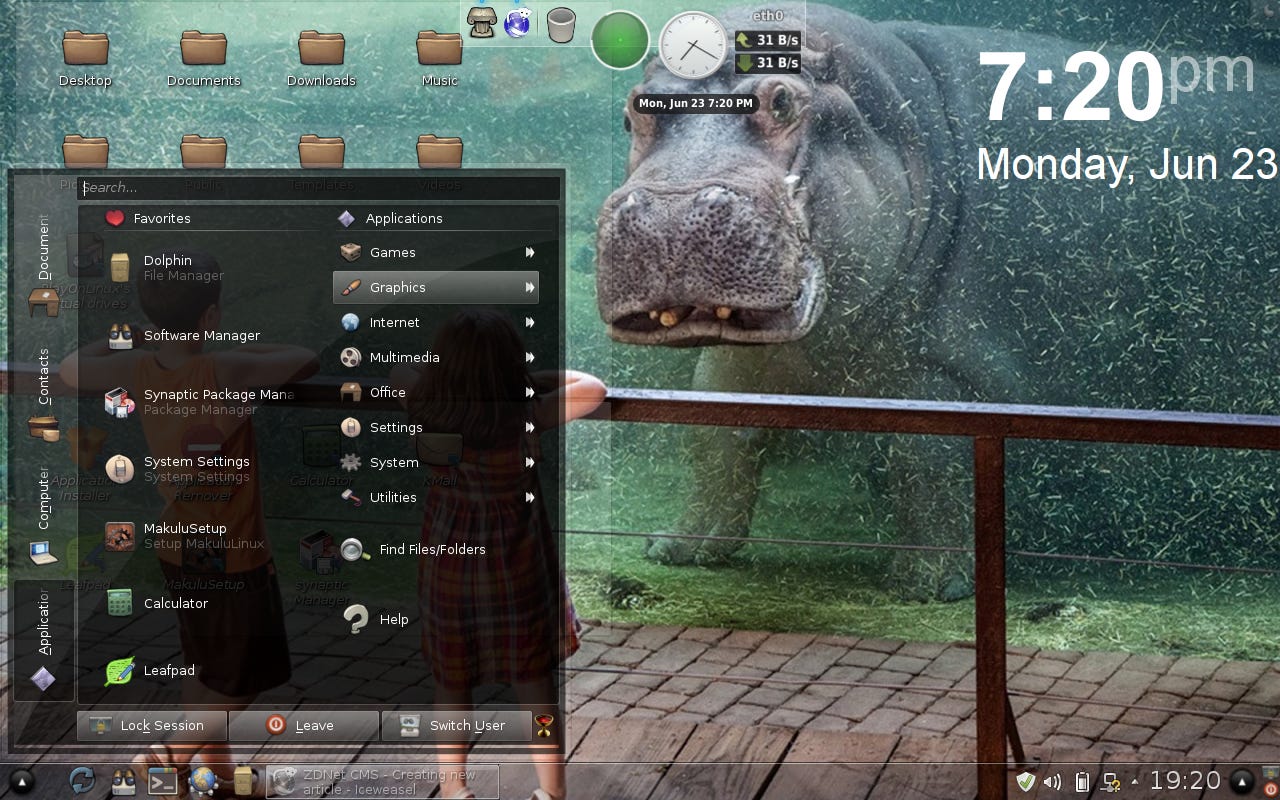Makulu Linux 6.0 KDE: Guaranteed to make you smile

Another Makulu Linux distribution was released today, and that's always good news! This time it is the KDE desktop for the Makulu 6.x series. The Xfce version of this was just released a couple of weeks ago, so I don't expect for there to be any major surprises: I hope that means this will not be a very lengthy post.
As usual, the release announcement gives a good overview of the what and why in this release. The most important specifics are that it is built on Linux kernel 3.14.7 and KDE SC 4.13.1. The download images are available from the Makulu Linux KDE page, it is a 32-bit (i686) build that is approximately 1.7GB in size. It is a hybrid ISO, so you can burn it to disk or dump it with dd to a USB stick, and it does not support UEFI boot.
When you boot the Live system and then click the 'Install' icon you are offered a choice between the 'Classic' and 'New' installers. The dialogue says that the classic installer is more verbose (asks more questions), so it does more of the system setup and configuration during the installation, and runs in 10 to 15 minutes, while the new installer has very few questions, leaves more of the setup and configuration to be done after the installation is complete, and takes much longer — about an hour or so.
In my opinion, the tradeoff is much simpler than that — as the new installer is still being tested and tuned by the Makulu developers, it can still be very cranky and refuse to install for obscure reasons, and it apparently doesn't like to install without an internet connection (for reasons unknown), and there is no reason for it to take an eternity to do its job.
I applaud the Makulu developers' efforts to bring in a more modern installer, and I will be very happy to use it once it is working properly, reliably and quickly. But for the moment I opt to stay with the Classic installer, which is a verbose pain in the behind, but it works well, it is fast, and you only have to put up with it once.
If you have ever used Makulu before, the installed system will look pretty familiar.

That is a very nice combination of the "all-in" Makulu desktop that we have seen before and the latest KDE release. The KDE bottom panel contains both the KDE menu (at the left end) and the 'slingscold' launcher (at the right end), and the 'docky' bar is at the top of the screen.
In this installation I have decided to try a different approach to using docky, and rather than set it up with common launchers — which are presumably already included in both the KDE menus and slingscold — I have set up docky with some common status and performance monitors. Here it has a CPU monitor, network monitor, and an analogue clock.
Rather than waste a lot of time rehashing the same things I just recently said about the Makulu Xfce 6.1 release, I will simply say that pretty much all of that applies here. It's big, it's beautiful, it's fun, and it is chock full of just about everything imaginable.
What I would like to spend a bit more time talking about is the package selection in this release. It is interesting, and it seems a bit quirky to me. It includes at least three web browsers — Konqueror, Chromium and Iceweasel — but only one mail program, Kmail, not Thunderbird or icedove.
It includes GIMP, but neither Gwenview nor digikam, so it seems that you are stuck waiting for GIMP to start even to view simple images, and you are completely without a photo manager. It includes Kingsoft Office, but not LibreOffice or Calligra. Oh, and just to confuse things further, the calculator and text editor listed in the menu favourites is 'gnome-calculator leafpad' rather than Kcalc and Kwrite. Kwrite is also listed in the menus, but I can't even find Kcalc!
Now, none of this is a serious problem, because everything I mentioned above as not included can be installed with a couple of clicks via either Synaptic or mintInstall (both are included in the base distribution). I'm just curious about how the selections were made, what got in and what didn't, and why?
Anyway, enough is enough. Makulu Linux is what it is — a big, beautiful, fun Linux distribution for hobbyists, and none of that requires or even implies that it should be consistent or "pure" to whatever desktop version you happen to be using.
As I have said before, if you want to have just about the most fun you can have with a Linux distribution, or if you just want to see a distribution packed with way more goodies than you are likely to find in any other single distribution, then give Makulu a try. I will guarantee that it will make you smile, and it will make you say "Wow, look at that!" a lot of times.
Further reading
- X Window System: 30 years on and still going strong
- Hands-on with Kali Linux 1.0.7
- Hardware upgrades (and some software headaches) with my new notebook
- Update overload: Setting up my new notebook
- Hands-on with Mint Cinnamon's Hot Corners
- Testing a new laptop with openSuSE, Fedora, Linux Mint and more
- Hands On: Linux Mint 17 Release Candidate